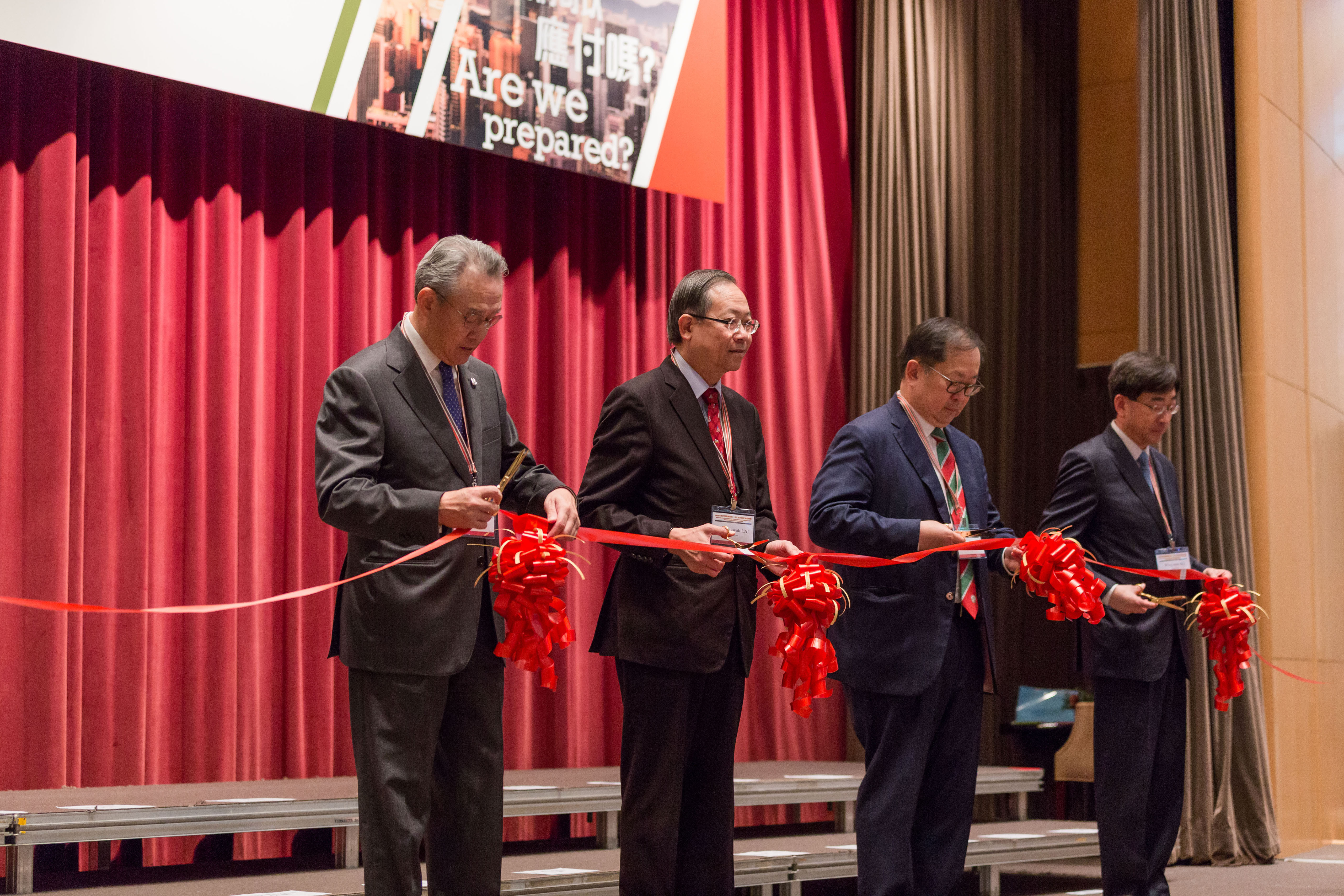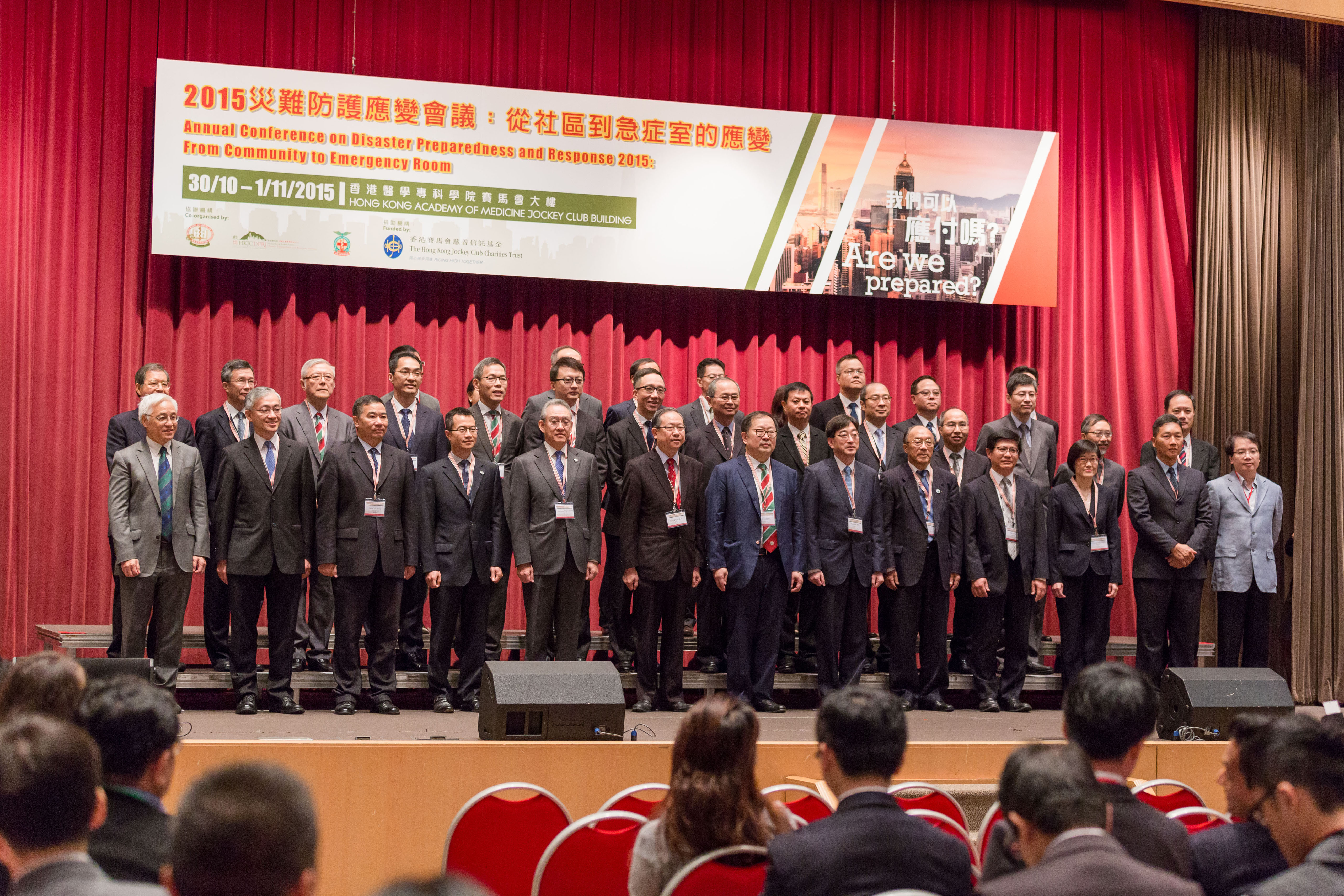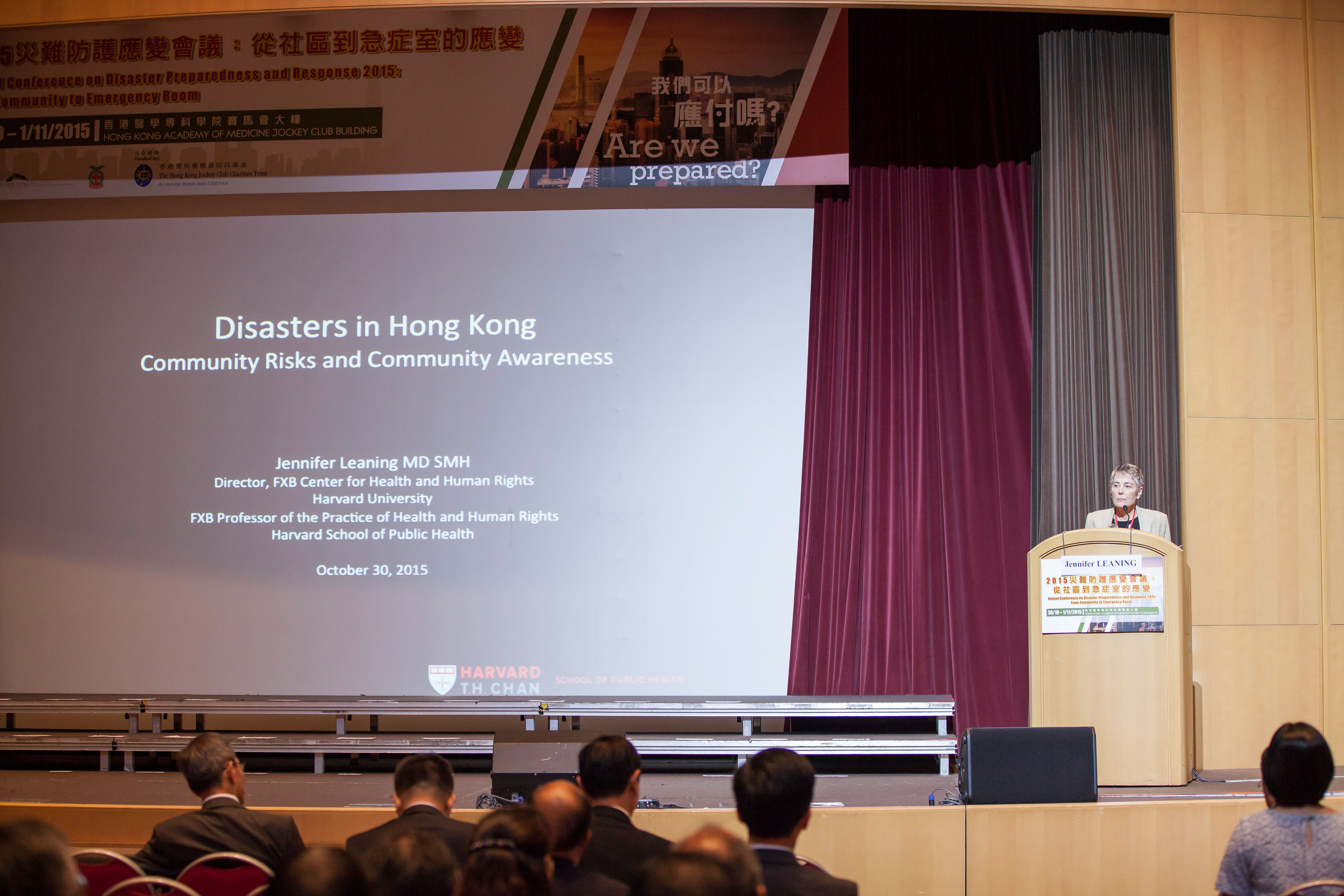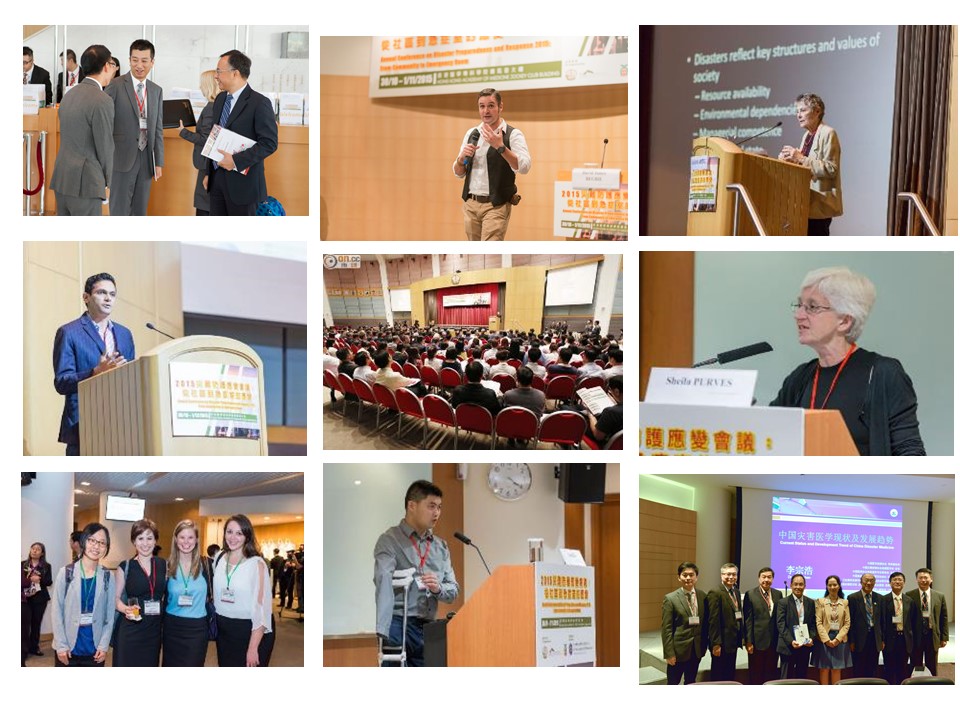Feature Story 2 - The 2015 Mina Stampede: a recurring tragedy
THE 2015 Hajj pilgrimage saw the worst stampede in 25 years in Saudi Arabia, despite billions of dollars spent on improving infrastructure and 100,000 security personnel deployed for the event. Let’s hear from Dr Rex Pui-kin LAM, clinical assistant professor of emergency medicine at The University of Hong Kong, about what we can learn from the tragedy

|
Primer Course for Clinical Skills in Disasters
Co-organised with the Emergency Medicine Unit, the University of Hong Kong and Accident & Emergency Training Centre of Hospital Authority, and supported by HKJCDPRI, the first class of the Primer Course for Clinical Skills in Disasters was held on 1 August 2015. So far, four classes have been conducted with 99 medical and nursing students being trained.
The course aims to introduce the basic concepts of disaster medicine to medical and nursing students. Students are taught about the principles of managing a disastrous incident, disaster triage procedures, basics of responding to a CBRN incident, and disaster medical care. Students also had the chance to get hands-on experience in using emergency response teams’ equipment and practicing radio communications protocol.
The one-day course ended with a mass casualty scenario where students had the opportunity to play various roles during a disaster response such as Paramedics, Emergency Teams, Incident Officers, and Hospital Authority Duty Officer. The students were able to work together and put what they had learnt into practice. |

|
A group photo taken at the Hospital Authority Accident and Emergency Training Centre after the first class held on 1 August 2015
|

|
Students learned to triage patients at the scene of a mass casualty scenario
|

|
Dr LEUNG Ling-pong of Emergency Medicine Unit of the University of Hong Kong coached students in providing medical care in a disaster setting
|

|
Instructors shared their experience of responding to a real-life disaster
|
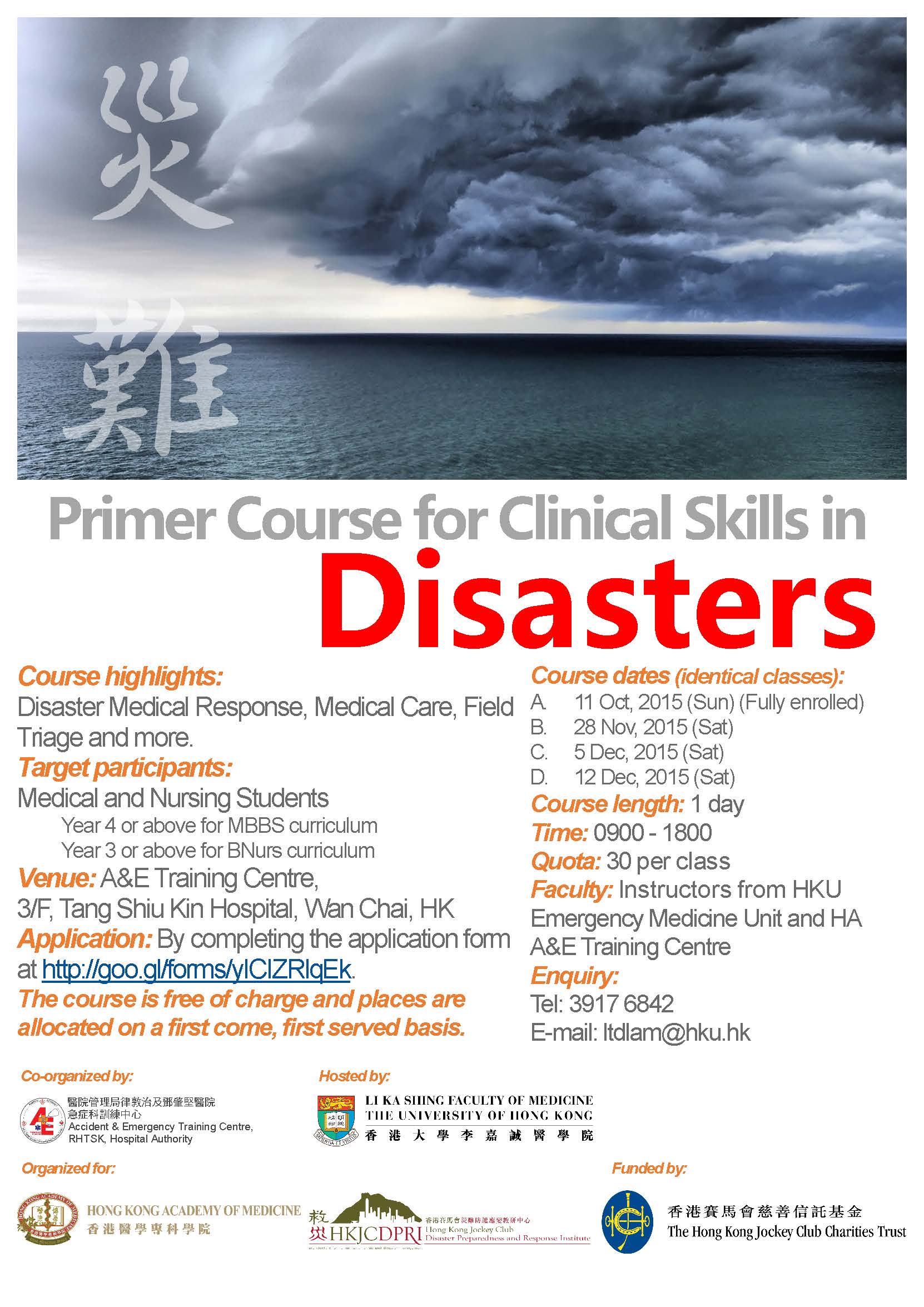
|
The second round of the course to be held from October to December 2015 has been launched. Please see the poster for details.
|

|
Disaster Field Responder Course
Supported by six frontline emergency response agencies; Ambulance Service Institute, Civil Aid Service, Fire Service Department, Hong Kong Disaster Medicine Association, Hong Kong Red Cross, and Hong Kong St John Ambulance, four full day lessons of Field Medical Procedures Simulation Training “Disaster Field Responder Course” was completed with 176 participants. The course aims to enhance first aiders’ disaster response capacity with updated knowledge and essential practical skills in disaster situations. It covers topics on command and coordination, practical first responders’ practical skills in disaster situations, special situations and scenarios, as well as psychological support. HKJCDPRI and the Hong Kong Jockey Club Innovative Learning Centre for Medicine (HKJCILCM) are currently planning the next course to be held in 2016 with more simulation-based learning elements including the XVR game-based learning and fully immersive virtual reality training. |
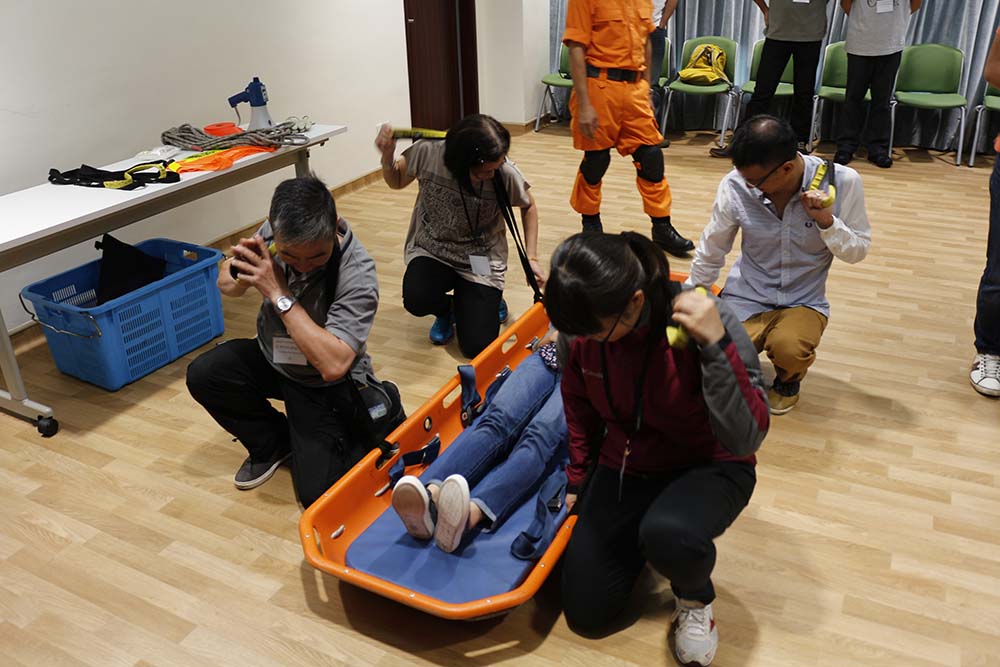
|
Practical and simulation-based learning is one of the main methodologies used in Disaster Field Responder Course
|
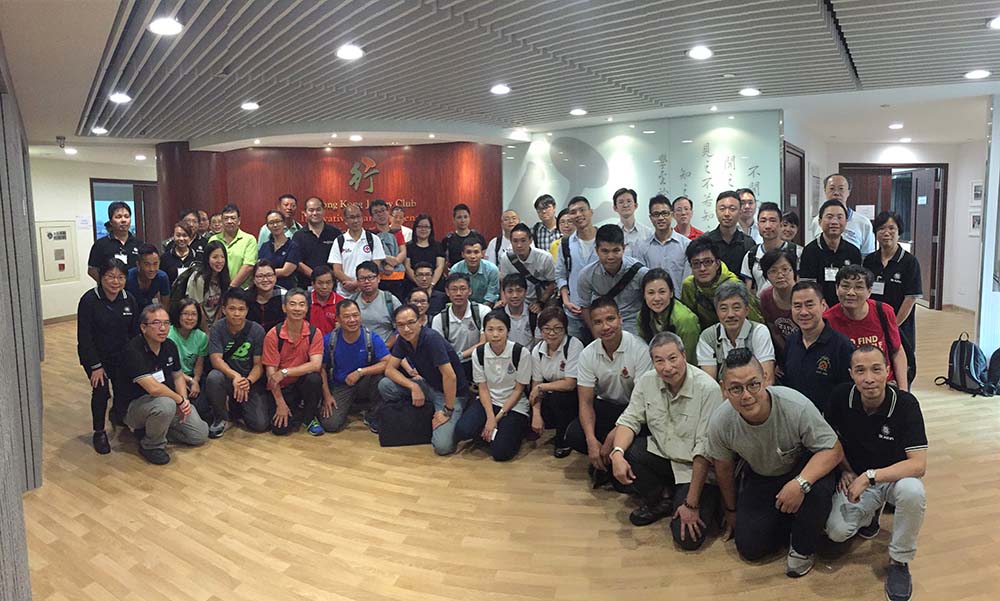
|
A group photo of course participants of Disaster Field Responder Course outside the Hong Kong Jockey Club Innovative Learning Centre for Medicine (HKJCILCM)
|

|
Train-the-Trainer Programme on Disaster Preparedness and Response for Hong Kong Secondary School Teachers
Asia-Pacific Region suffers the highest number of disasters across the globe. As Hong Kong is a key member in the region, both its public health and education sectors should play pivotal roles in disaster preparedness and response. The Collaborating Centre for Oxford University and CUHK for Disaster and Medical Humanitarian Response (CCOUC) and HKJCDPRI jointly organised the Train-the-Trainer Programme on Disaster Preparedness and Response for Secondary School Teachers to be complementary to the secondary school Liberal Studies curriculum. The programme aims to strengthen community resilience and promote disaster awareness in Hong Kong, one of the most densely populated cities in the world.
The train-the-trainer programme kicked off on 13 Oct 2015. Professor Emily CHAN, the Director of CCOUC, delivered the first training entitled “The Relationship between Disasters and Public Health Using Hong Kong as a Case Study”, which was well received by course participants. Common disasters in Hong Kong, myths of disasters, disaster preparedness and responses were discussed. Teachers from various secondary schools revealed their interests in incorporating these issues into their current Liberal Studies curriculum, and would help distribute learning booklets prepared by CCOUC to their students. CCOUC believes that secondary school teachers will be important agents to disseminate the crucial messages of disaster preparedness to the younger generation and the corresponding households.
In the coming year, three more topics will be introduced, namely, "Environmental Hazards and Public Health Responses in Hong Kong", "Infectious Diseases and Epidemiology: Why is the Threat of Infectious Diseases Growing?", and the "Impact of Globalization on Climate Change and Population". To know more about the programme, please visit:
http://ccouc.org |

|
Professor Emily CHAN delivered the first training entitled “The Relationship between Disasters and Public Health Using Hong Kong as a Case Study” on 13 Oct 2015
|

|
Participating teachers discussed the case study during the training course
|

|
The HKJCDPRI E-portal and E-learning Modules Launched

|
Post-disaster Emergency Rehabilitation Service Manual and One-stop Rehabilitation Service Management Manual
Long-term disability is one of the most damaging impact caused by disaster to individuals and the society.The 2008 Sichuan earthquake left many people disabled who required long-term rehabilitation care. In July 2008, the Hong Kong Red Cross, in partnership with the Deyang Prefectural Red Cross and Deyang Disabled Persons’ Federation in Sichuan Province, established the Deyang Disabled Persons’ Federation, Hong Kong Red Cross Rehabilitation, Prosthetic and Orthotic (P&O) Center. The Deyang Rehabilitation and P&O Center provided one-stop multi-disciplinary rehabilitation service to the people affected by 2008 Sichuan Earthquake and was well received by the service users, government departments and other organizations for its service model and quality. Upon completion of our 5-year mission, the Hong Kong Red Cross handed over the Deyang Rehabilitation and P&O Center to the Deyang Disabled Persons’ Federation in June 2013 and the center was renamed as the Deyang Disabled Persons’ Federation Red Cross Bo Ai Rehabilitation and P&O Center. To capture the valuable experience of the team from set-up of the multi-disciplinary service in emergency phase to the rehabilitation phase of a disaster, the Hong Kong Red Cross developed and published two manuals, the Post-disaster Emergency Rehabilitation Service Manual and the One-stop Rehabilitation Service Management Manual, to capture the valuable experience of setting up multi-disciplinary rehabilitation service after a disaster. The manuals are free to download.
|
|
|
If you have any comments and feedback on the manuals, please contact Ms Eleanor LAM, Senior Manager (Quality and Accountability) of Hong Kong Red Cross, at [email protected].
Enjoy reading!
|

|
JOIN US “Be Part of this Architecture for Humanitarian Crisis and Disaster Management”
|
CONTACTS
Hong Kong Jockey Club Disaster Preparedness and Response Institute
Address:
Room 901, Hong Kong Academy of Medicine Jockey Club Building, 99 Wong Chuk Hang Road, Aberdeen, Hong Kong
Telephone:2871 8507
Fax : 2296 4628
Email: [email protected] |
If you wish to be removed from our mailing list, please send email to [email protected]
MEMBERS OF THE EDITORIAL COMMITTEE
Chair
Dr Kevin HUNG
Members
Prof Chak-sing LAU
Dr Chor-chiu LAU
Dr Chun-tak LUI
Dr Donald LI (ex officio member)
Prof Emily CHAN
Prof Ignatius YU
Dr Tai-wai WONG
Dr Tung-ning CHAN
|
|



